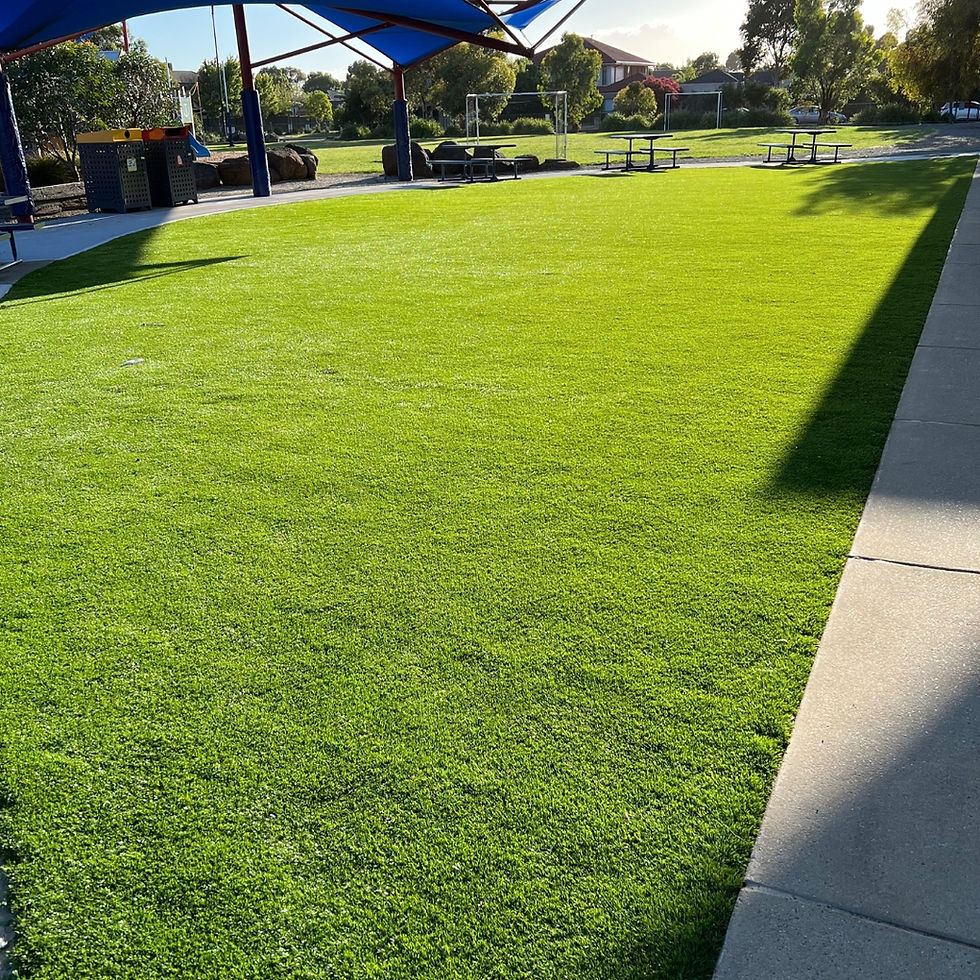Ten benefits of high quality artificial grass in schools
- Sporting Courts Australia

- Aug 14
- 3 min read
In recent years, artificial grass has become increasingly popular in schools. Educators and administrators are discovering the many advantages that high-quality artificial grass can provide. These benefits not only enhance the learning environment but also improve the overall experience for students. Here are ten compelling reasons why artificial grass can be a game changer for educational institutions.
1. Low Maintenance Requirements
One of the standout benefits of artificial grass is its low maintenance needs. Traditional grass requires regular mowing, watering, and fertilizing. In contrast, artificial grass needs minimal upkeep. Schools can redirect these resources toward educational activities rather than grass care. For example, maintenance costs for artificial grass can be reduced by up to 80% compared to natural grass.
2. Durability and Longevity
High-quality artificial grass is designed for durability. It can endure the heavy foot traffic typical in schools without showing wear and tear. For instance, a well-installed artificial turf field can last between 10 to 15 years with proper care. This durability ensures that sports fields and playgrounds remain safe and enjoyable for students throughout the school year.
3. Enhanced Safety
Safety is a major concern in school environments, and artificial grass often incorporates shock-absorbing properties. These features significantly reduce the risk of injuries during falls, additionally, artificial grass is also designed to be applied to soft fall underlays where required. For example, studies show that synthetic grass can lower fall-related injuries by up to 50%. This soft surface provides a safer play area where children can engage in various activities without worrying about potential injuries.
4. Environmental Benefits
Contrary to common beliefs, artificial grass can have environmental advantages. It can drastically cut down water usage by up to 50% since there is no need for constant irrigation. Additionally, without the need for chemical fertilizers or pesticides, schools can maintain a healthier ecosystem. This not only benefits the environment but also promotes better health for students and staff alike.
5. Year-Round Usability
One of artificial grass's most appealing aspects is its ability to stay usable all year, regardless of weather. Whether it's sunny or raining, students can participate in outdoor activities without worrying about muddy or damaged fields. In fact, schools that switch to artificial grass report a 30% increase in outdoor playtime, leading to a healthier lifestyle for students.
6. Aesthetic Appeal
Artificial grass offers a consistently lush and vibrant look. This aesthetic enhancement makes school grounds more inviting for students and visitors. A study indicated that schools with appealing landscapes, including artificial turf, saw a 10% increase in student and parent attendance during events. A visually attractive outdoor space can also serve as a gathering point for activities and community events.
7. Cost-Effectiveness
Although the initial investment for artificial grass might be higher than that of natural grass, the long-term savings can be significant. Schools can save on maintenance, water bills, and upkeep costs. Over a 10-year period, the switch to artificial grass can save schools significantly on maintenance and repair costs.
8. Versatility in Use
Artificial grass is versatile and can be used for various applications within schools, including sports fields, playgrounds, and landscaping. Schools can create multifunctional outdoor spaces that cater to different needs. For example, a single field can host soccer games, community events, and serve as a general play area, maximizing usage for students.
9. Improved Air Quality
Interestingly, artificial grass can aid in improving air quality. Since it does not require chemical fertilizers and pesticides, schools can maintain a healthier atmosphere. Furthermore, synthetic grass does not release pollen, which is particularly beneficial for students with allergies. The reduced need for maintenance chemicals contributes to a cleaner environment, allowing students to breathe easier while enjoying outdoor time.
10. Encouragement of Physical Activity
Lastly, having artificial grass can promote physical activity among students. With a safe, durable, and pleasing surface, students are more likely to engage in outdoor sports and playtime. Increased physical activity has been correlated with better health outcomes, including improved focus and academic performance. Schools have reported that switching to artificial grass led to a 20% rise in student participation in physical activities.

Final Thoughts
The advantages of high-quality artificial grass in schools are extensive. With its low maintenance, enhanced safety, environmental benefits, and cost-effectiveness, artificial grass can transform educational institutions. By investing in this innovative solution, schools can create a safer, more engaging, and sustainable environment for students. The future of school facilities looks promising with artificial grass playing a pivotal role in nurturing health, activity, and learning among students.



Comments